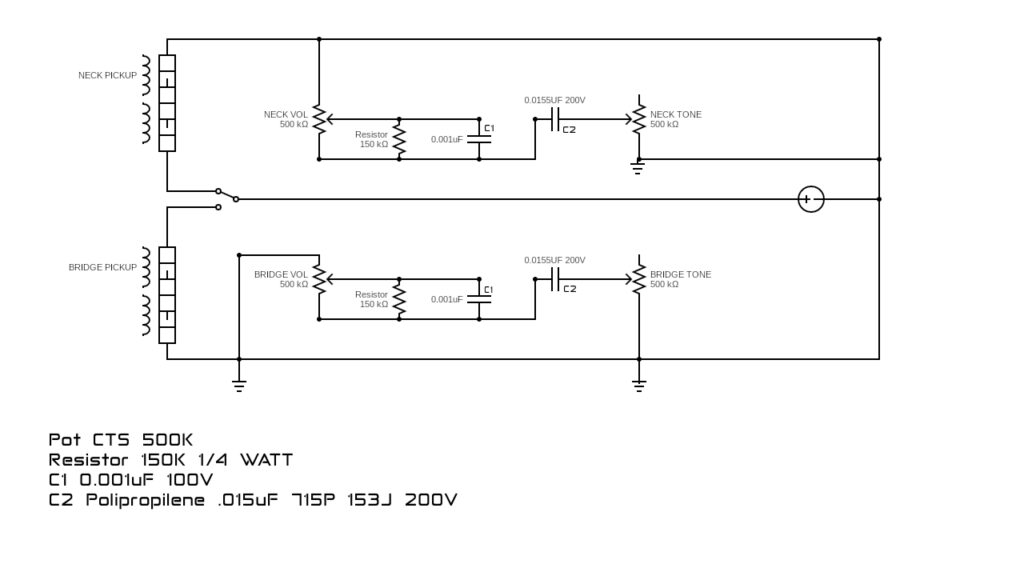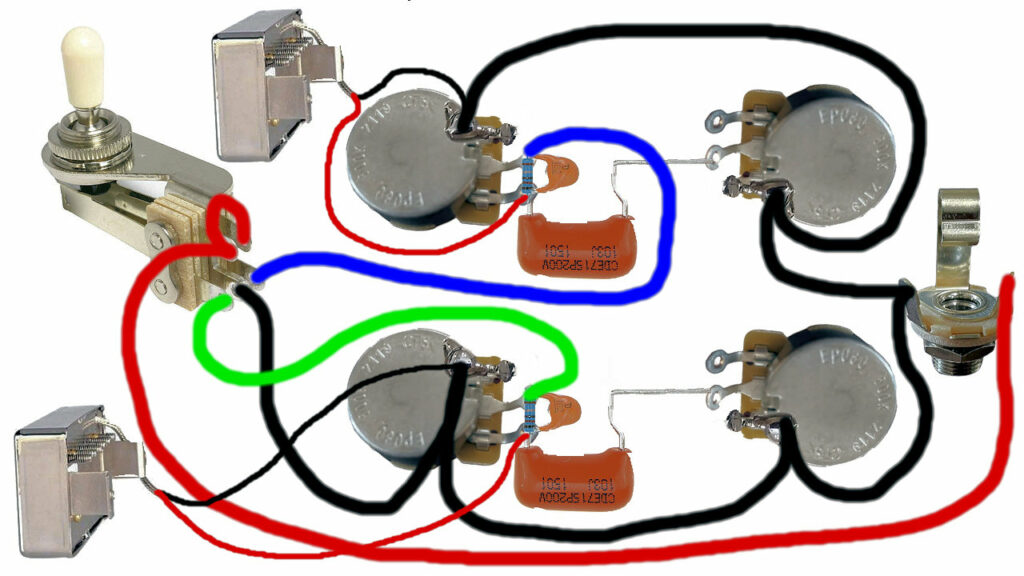Gibson SG upgrade video in IT:
The creation of the mod. it does not present particular difficulties in itself, the video shows in detail the most complicated phases to carry out.
The technical concepts that lead to preferring air wiring and above all the implementation or otherwise of treble bleed deserve a separate discussion. To begin with, the following are the electrical and assembly diagrams essential for self-building hand wiring.


Hand wiring brings to mind the first creations of the 1950s and I am of the opinion that if it has generated historic sounds for decades it should not be replaced by the PCB just to reduce the use of artisan labor or to be able to use standardized components.
My personal considerations regarding the hand wiring and therefore the Gibson SG Upgrade:
Sound and Tonality: Thanks to the lower density of connections and the absence of a large PCB, spurious capacitance and inductance can be reduced, positively influencing the tonality which I perceive as warmer and more present.
Customization: Hand wiring allows for greater customization. Guitarists looking to shape their sound in very specific ways find that hand-wiring offers more flexibility for custom tweaks and adjustments.
Repairability: While broken PCBs must be replaced, hand wiring can be easier to repair even by those with minimal electronics skills. You can re-solder a wire or replace a single component without having to replace the entire board.
Quality Construction: Hand wiring can be seen as a sign of quality craftsmanship and attention to detail. In an age of mass production, a hand-wired guitar can be considered unique and possess greater intrinsic value.
Historic and Vintage Value: Historic and vintage models always feature hand wiring. For those wanting a period-accurate reproduction or looking to maintain the authenticity of an antique guitar, hand-wiring is a must.
Higher Quality Components: Hand-wiring allows the use of higher quality components that are not always PCB compatible, such as boutique capacitors or specialized potentiometers.
Less Electronic Interference: Hand wiring can reduce electromagnetic interference within the circuit, as each component can be optimally positioned and oriented to minimize noise.
It should be noted that these are personal perceptions that certainly vary from guitarist to guitarist. Many, on the contrary, state that the difference in sound between PCB and hand wiring is minimal or non-existent, so the preference for air wiring is often just a matter of personal taste and appreciation for tradition and craftsmanship.
My considerations on why the implementation of treble bleed in your guitar is to be considered useful if not essential:
The implementation of the “treble bleed” circuit, on an electric guitar, is done for several reasons, especially for guitarists who want to maintain clarity and definition of the high frequencies when turning down the volume of their instrument.
In summary, some reasons to choose it:
High Frequency Retention: Without a treble bleed, turning the volume knob down can cause significant loss of high frequencies, making the sound darker and duller. The treble bleed allows you to maintain a brilliant sound even at low volumes.
Better Tone Control: Allows guitarists to have more precise control over the tones of their instrument, without having to rely solely on the tone pot or external devices.
Improved Dynamics: Helps maintain the guitar’s dynamic response even at lower volumes, essential for guitarists who use volume controls to adapt their dynamics during a performance.
Versatility: The treble bleed is particularly useful in live and studio contexts where you need to vary the volume without losing sound quality, making the instrument more versatile.
Ease of Installation: It is relatively easy to install and can be considered an economical upgrade that significantly improves the performance of the instrument.
Sound Customization: Treble bleed circuit components can be selected and combined to suit individual preferences, giving players the ability to customize the behavior of their guitar.
In summary, treble bleed is praised for its positive impact on sound quality, especially at lower volume levels.
Technical details regarding the treble bleed:
The treble bleed is a high pass filter. In electronics, a high-pass filter allows high frequencies to pass through and attenuates low frequencies. In the context of treble bleed for guitars, its specific purpose is to maintain the high frequencies of the guitar when you turn down the volume, counteracting the unwanted effect of loss of shimmer.
The treble bleed circuit, composed of a resistor and a capacitor, behaves like a high-pass filter because the capacitor offers less resistance at high frequencies and greater resistance at low frequencies. So, as you lower the volume and the total resistance of the circuit increases, the high frequencies can “bypass” the potentiometer through the capacitor, while the low frequencies are attenuated more.
The result is that even at the lowest volumes, the sound retains its clarity and definition, avoiding becoming too dark or dull, which is a common effect when turning the volume down without a treble bleed circuit, making a strong case for perform the Gibson SG Upgrade.
Here are some reference values relating to the resistor and capacitor to use:
Resistors: Common values can be between 100kΩ and 250kΩ. The specific value depends on the degree of effect desired and the type of potentiometer used. In the circuit created in the video the resistance has a value of 150kΩ as regards the dissipation power, considering the very low current values involved, 1/4 of a watt is more than sufficient.
Capacitors: Typical values range from approximately 680pF up to 22nF. Lower capacity values will tend to retain less treble, while higher values will retain them more. I used a 0.001uF capacitor.
The choice of specific values will depend on the sound you want and the exact effect you want to achieve, and often requires a bit of experimentation. A good starting point for experimentation would be a 150kΩ resistor with a 0.001uF capacitor.
If your volume pot has a lower value, 250kΩ for example, which is common for guitars with single-coil pickups, you might start with lower resistance and capacitance values for the treble bleed. For pots with higher values, such as the mod’s 500kΩ, which are often used with humbuckers, you might want to choose higher values to maintain the high frequencies when turning the volume down.
I hope, at this point, to have been of help to you in the decision, or not, to upgrade the Gibson SG by equipping it with hand wiring with treble bleed.
If you wish to comment or ask for clarifications you can do so in the comments section of my YouTube channel.
If you wish to delve deeper into the topic, you could visit the dedicated section here on the site.

 it_IT
it_IT